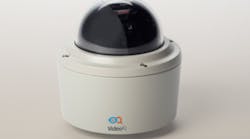Last month, video surveillance solutions manufacturer Avigilon acquired video analytic patents from four different companies - Behavioral Recognition Systems, Inc. (BRS Labs), FaceDouble Incorporated, ITS7 Pty Ltd., and VideoMining Corporation - for just over $13 million. This follows the company’s purchase of the entire patent portfolio and patent licensing program of ObjectVideo in late December for more than $80 million. With these recent acquisitions combined with their purchase of VideoIQ in late 2013, Avigilon now holds 213 U.S. and international patents and 215 U.S. and international patent applications.
According to Alexander Fernandes, Avigilon’s founder, president, CEO and chairman of the board, the main impetus behind the company’s decision to acquire this vast portfolio of intellectual property stems from their belief that the future of the surveillance industry lies in video analytics.
“What we think is happening now is that a commoditization of hardware, particularly IP and megapixel camera, is underway. There is an increasing influx of typically Asian-made, low-cost cameras hitting the market, which is to be expected and is not something we’re surprised by,” said Fernandes. “We embrace that and we view ourselves as a pretty lean, low-cost manufacturer as well, but we also have high-end products. We see this ongoing commoditization on the hardware side and we see in the area of VMS and software the ability to continue to differentiate ourselves and add value for our customers with video analytics.”
Within the next seven years, Fernandes said they believe that sales of HD surveillance cameras will become ubiquitous in the market and that new sales of analog cameras will pretty much come to an end. Because of that, the real value for end users moving forward will be delivered by the intelligence features provided in the video hardware and software solutions that compose their surveillance network.
“The first step in our strategy towards dominating and really being in the driver’s seat of video analytics was to acquire what we believed was the most robust video analytics technology in VideoIQ. In terms of camera technology, algorithms, object recognition and everything else that goes into the analytics, we really felt that VideoIQ was head and shoulders the leader,” he said. “Since then, we have begun to incorporate their analytic capabilities into our cameras and into our video management software. The more recent acquisitions are really aimed at owning and controlling the intellectual property around analytics. In terms of intellectual property, we have what we feel is the most advanced and robust video analytic technology and we now own what we believe is the strongest portfolio of patents around video analytics. So, we are essentially putting our stake in the ground in terms of protecting our investments going forward in video analytics and we really aim to be at the forefront in paving the way for this video analytics revolution in the industry over the next five to 10 years.”
Although video analytics have not been held in the highest esteem by end users given the unrealistic promises made by some vendors in the past, Fernandes said that there were really two key barriers to their mass market adoption; economics and technical hurdles.
“There were a half a dozen or so video analytics companies out there in the world… and they all had the same problem to varying degrees which was that they were all trying to sell their analytics as essentially an add-on or adjunct to an existing system,” explained Fernandes. “Basically, IP cameras, they are all kind of different and VMS systems are all different, along with the formats, resolutions, and so forth. So, there were these integration problems that constantly occurred. On a cost basis, there were also problems, because they were all trying to charge $500 to $2,000 per video channel and that’s simply just priced way out of the market. We believe people will spend between $30 to $50 to $60 for analytics on a per channel basis, not $500 or $1,000. Basically, all of the analytics companies were pricing themselves out of the market.”
Fernandes said that to work properly, analytics need to be embedded in the cameras themselves, as well as the video management platform the end user is leveraging. Since acquiring VideoIQ, Avigilon has extracted the analytics from their respective products and starting embedding them in their own camera platform.
“Now our 1-, 2- and 3-megapixel cameras have built-in analytics and over the rest of this year, we will be rolling out analytics in all of our cameras,” added Fernandes. “It is also built into our VMS, so we’re able to offer analytics at an extremely attractive price point, a lower cost than anyone else and it is only a very small fee to get the analytics. More importantly, because it is fully integrated at the factory design level, (the analytics) work seamlessly. At the end of the day, there is no separate, stand-alone market for video analytics.”
While VideoIQ was acquired as a whole and has subsequently been fully integrated into Avigilon, Fernandes emphasized that these most recent patent acquisitions were asset purchases only.
“We did not purchase the businesses, we simply purchased all of their patents so it is really just taking ownership of the patents,” he said. “But we did not acquire the operational side of their businesses, just the patents. With ObjectVideo, we brought on a handful of (people from) essentially their licensing department, a few lawyers and a few administration personnel related to the licensing program.”
Fernandes said that Avigilon views analytics as the “lever” that could propel the company from being one of the fastest growing video surveillance companies in the global market to being the dominant manufacturer.
“Imagine you have two different automobiles from two different manufacturers with identical specs – the same performance, price point – but one of the cars has air conditioning and a stereo and the other car doesn’t,” he said. “Normally, people would want the one with the better features. Our businesses is not about selling analytics widgets or analytics as a standalone, we see it as being integral to video and providing more value to the end user. It will transform surveillance from what it is today as a post-incident, forensic investigative tool into a proactive event prevention tool.”





